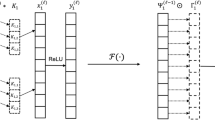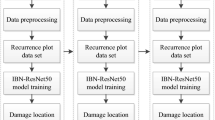Abstract
In the last few years, structural damage identification has been considered a strong area of research by the structure engineers community. Vibration-based damage identification using machine learning algorithms has shown a tremendous advantage over other damage identification procedures. Although existing damage detection methods have been adapting machine learning principles, the majority of machine learning-based procedures extract fixed features. Depending on the framework under investigation, their output differs significantly across different data patterns. During the training process, deep learning technique convolution neural networks (CNNs) will fuse and adjust two key sets of an assessment assignment (feature extraction and classification) into a sole learning block that is manually identified in advance. This capability not only improves classification accuracy, but it also improves computational performance. In the proposed work, a damage identification study has been carried out using deep learning CNN algorithms. The performance of two CNN models one-dimensional (1D) CNN and two-dimensional (2D) CNN is discussed. This approach is verified using an analytical model of G+20 storey building modelled in FEM-based software. Probability of damage (POD) is used as the damage indicator in the analysis. It has been witnessed that the presentation of 1D CNN is superior to 2D CNN for damage diagnosis.
Access this chapter
Tax calculation will be finalised at checkout
Purchases are for personal use only
Similar content being viewed by others
References
Brownjohn JM (2007) Structural health monitoring of civil infrastructure. Philos Trans Royal Soc A: Math, Phys Eng Sci 365(1851):589–622
Catbas FN (2009) 1—structural health monitoring: applications and data analysis. Struct Health Monit Civil Infrastruct Syst
Chang KC, Kim CW (2016) Modal-parameter identification and vibration-based damage detection of a damaged steel truss bridge. Eng Struct 122:156–173
Sohn H, Farrar CR, Hunter NF, Worden K, Structural health monitoring using statistical pattern recognition techniques. J Dyn Syst Meas Control 123
Kaloni S, Shrikhande M (2017, Jan 9–13) Damage detection in structural system via blind source separation. In: Proceedings of 16th world conference in earthquake engineering. Santiago Chile
Kaloni S, Shrikhande M (2018) Seismic damage detection using blind source separation in 16th symposium on earthquake engineering. Indian Institute of Technology Roorkee, India
Figueiredo E, Park G, Farrar CR, Worden K, Figueiras J (2011) Machine learning algorithms for damage detection under operational and environmental variability struct. Health Monit 10:559–572
Gul M, Catbas FN (2011) Structural health monitoring and damage assessment using a novel time series analysis methodology with sensor clustering. J Sound Vib
Adeli H (2001) Neural networks in civil engineering: 1989–2000. Comput-Aided Civil Infrastruct Eng 16(2):126–142
Alzubi JA (2015) Optimal classifier ensemble design based on cooperative game theory. Res J Appl Sci Eng Technol 11(12):1336–1343
Alzubi JA, Jain R, Kathuria A, Khandelwal A, Saxena A, Singh A (2020) Paraphrase identification using collaborative adversarial networks. J Intell Fuzzy Syst 39(1):1021–1032
Omar AA, Alzubi JA, Mohammed A, Issa Q, Sara Al-S, Manikandan R (2020) An optimal pruning algorithm of classifier ensembles: dynamic programming approach”. Neural Comput Appl
Acharya UR, Oh SL, Hagiwara Y, Tan JH, Adam M, Gertych A, San Tan R (2017) A deep convolutional neural network model to classify heartbeats. Comput Biol Med 89:389–396
Adeli H, Jiang X (2006) Dynamic fuzzy wavelet neural network model for structural system identification. J Struct Eng 132(1):102–111
Agarwal N, Sondhi A, Chopra K, Singh G (2021) Transfer learning: survey and classification. In: Smart innovations in communication and computational sciences, pp 145–155. Springer, Singapore
Liu Y-Y, Ju Y-F, Duan C-D, Zhao X-F (2011) Structure damage diagnosis using neural net-work and feature fusion. Eng Appl Artif Intell 24:87–92
Chun PJ, Yamashita H, Furukawa S (2015) Bridge damage severity quantification using multipoint acceleration measurement and artificial neural networks. Shock Vib
Avci O, Abdeljaber O, Kiranyaz S, Inman D (2019, May) Convolutional neural networks for real-time and wireless damage detection. In: Dynamics of civil structures, volume 2: proceedings of the 37th IMAC, a conference and exposition on structural dy-namics. Springer, p 129
Avci O, Abdeljaber O, Kiranyaz S, Inman D (2020) Convolutional neural net-works for real-time and wireless damage detection. In: Dynamics of civil structures, vol 2. Springer, Cham, pp 129–136
SAP2000 Integrated software for structural analysis and design, computers & structures, Inc., Berkley, CA, USA
FEMA-356 (2000) Prestandard and commentary for the seismic rehabilitation of buildings American society of civil engineers
Author information
Authors and Affiliations
Editor information
Editors and Affiliations
Rights and permissions
Copyright information
© 2022 The Author(s), under exclusive license to Springer Nature Singapore Pte Ltd.
About this paper
Cite this paper
Pandit, V., Kaloni, S., Sharma, S., Singh, G. (2022). Damage Identification in High-Rise Buildings Using Deep Learning Techniques. In: Gupta, D., Polkowski, Z., Khanna, A., Bhattacharyya, S., Castillo, O. (eds) Proceedings of Data Analytics and Management . Lecture Notes on Data Engineering and Communications Technologies, vol 90. Springer, Singapore. https://doi.org/10.1007/978-981-16-6289-8_33
Download citation
DOI: https://doi.org/10.1007/978-981-16-6289-8_33
Published:
Publisher Name: Springer, Singapore
Print ISBN: 978-981-16-6288-1
Online ISBN: 978-981-16-6289-8
eBook Packages: Intelligent Technologies and RoboticsIntelligent Technologies and Robotics (R0)




